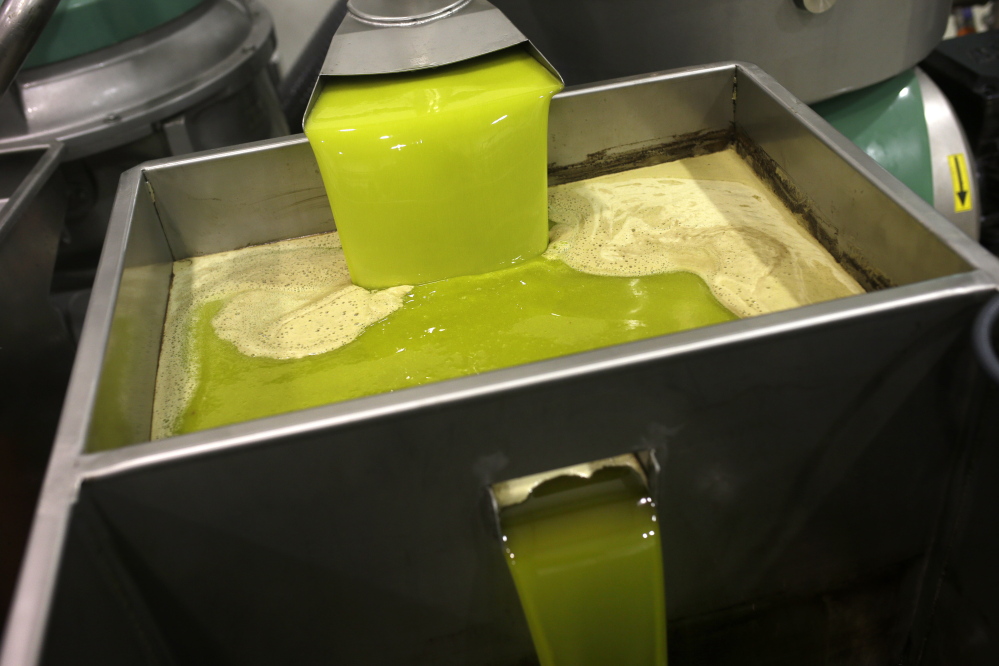BEJA, Portugal — If your favorite bottle of Mediterranean olive oil starts costing more, blame unseasonable European weather — and tiny insects.
High spring temperatures, a cool summer and abundant rain are taking a big bite out of the olive harvest in some key regions of Italy, Spain, France and Portugal. Those conditions have also helped the proliferation of the olive fly and olive moth, which are calamitous blights.
The shortfall could translate into higher shelf prices for some olive oils and is dealing another blow to southern Europe’s bruised economies as they limp out of a protracted financial crisis.
“The law of supply and demand is a basic law of the market,” said Joaquim Freire de Andrade, president of growers’ association Olivum in Portugal’s southern Alentejo region, the country’s olive heartland. “It’s a tough year.”
Olive oil is big business in southern European Union countries. They are the source of more than 70 percent of the world’s olive oil, bringing export revenue of almost $2.2 billion last year. The United States imported just over $800 million of that.
For some European growers, this year’s harvest is a bust.
In Spain, the world’s biggest producer, the young farmers’ association Asaja says 2014 is “another disaster” after a calamitous harvest two years ago. Spain’s output is forecast to plunge by more than 50 percent, with a drop of at least 60 percent in the southern Andalucia region.
Several factors have combined to hurt Spain. Trees are exhausted after last year’s bumper harvest. Also, unusually high spring temperatures choked flowering. On top of that, some producers are battling swarms of olive flies and moths.
Consumers are already paying 1 euro a liter more for their olive oil, Asaja president Luis Carlos Valero says, though he doesn’t anticipate a hefty price jump.
For celebrated Italian olive oil producers, “this is the worst year in memory,” said Pietro Sandali, head of the Italian olive growers’ consortium, Unaprol. The group expects a 35 percent drop in national production this year.
After heavy spring and summer rain, some growers didn’t bother to harvest their meager crop. For some who did, the volume is low and the quality is poor.
“This crop is not to be remembered. This is a crop to be forgotten in every aspect,” said Augusto Spagnoli, an organic olive grower from Nerola, about 50 kilometers from Rome, as he stood amid his 10,000 trees, some of which are more than 1,600 years old.
The bulk price for extra virgin oil from the benchmark Bari region has soared to 6 euros a kilogram — up from 2.7 euros this time last year.
French growers say they face their most daunting crisis since a big freeze in 1956 decimated olive groves. This year’s harvest was initially expected to fetch some 5,000 metric tons of olive oil but it may reach only 1,500 metric tons, according to the Inter-professional French Olives Association.
The big culprit there is a fly the size of a small ant. The fly pricks olives and places larvae inside, and the maggots tunnel through the fruit. The flies have long been a problem for olive oil producers, but the scale this year has astonished farmers.
“I’d never seen this and the older folks said they’d never seen such a proliferation of flies,” said producer Laurent Belorgey, part of a third generation of olive growers at the 19th-century Domaine de la Lieutenante, south of Avignon.
In Beja, 180 kilometers (110 miles) southeast of the Portuguese capital Lisbon, producers deploy satellite technology on their high-tech farms these days but after generations they are still fighting age-old enemies: the olive fly and a fruit fungus that turns olives brown and makes them shrivel like prunes. Both blights have struck hard this year.
Portuguese growers are doing what the French have done: harvesting earlier and faster than usual before any more is lost. Since mid-October, a month earlier than usual, crews have been hurrying through the long ranks of olive trees that stretch to the horizon.
The workers follow a low, agile, space-age-looking vehicle that clamps the tree trunk and shakes it, briefly making the tree shimmer in a silver-green blur. Long black netting on the ground catches the falling olives.
Though less damaged, the younger fruit also yields less oil. “Farmers will be earning less this year,” said Freire de Andrade, the Olivum association president.
Greek growers, however, anticipate windfall profits. Greece is the world’s third-largest producer and is set to more than double its annual output, to 300,000 metric tons. That is good news for farms in places such as Crete and the southern Peloponnese region where Greece’s acute financial crisis in recent years had left growers short of cash for maintenance and investment.
The predicted shrinkage in EU output should also be offset in part, experts say, by Spanish stocks left over from last year’s record yield.
Send questions/comments to the editors.


